|
|
|
Sort Order |
|
|
|
Items / Page
|
|
|
|
|
|
|
| Srl | Item |
| 1 |
ID:
167025
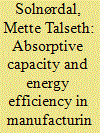

|
|
|
|
|
| Summary/Abstract |
Increased energy efficiency (EE) in manufacturing firms is important for confronting climate challenges. However, the information barrier is considered a major restriction on EE innovation. Building on the theory of absorptive capacity and the current EE literature, we argue that this barrier relates to firms' ability to assimilate and exploit information. Thus, this study's objective is to analyse firms' knowledge characteristics as determinants of EE innovation. We perform logit regressions using a Norwegian panel dataset for the period 2010–2014. The results are based on statistical correlations between data points that have potential uncertainties. Still, the main implications from our study are that prior knowledge, in terms of higher educated workforce, knowledge development, in terms of R&D capacity, and external knowledge cooperation, such as cooperation with universities and competitors, increase firms' pursuit of EE innovation. Further, the results also imply that there is an interaction effect between higher educated workforce and collaboration with universities. These results suggest that policy makers should consider firms' ability to assimilate and exploit information. This can be done by providing information according to firms' needs and absorptive capacity, and offering possibilities for firms to increase this capacity.
|
|
|
|
|
|
|
|
|
|
|
|
|
|
|
|
| 2 |
ID:
167000
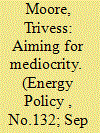

|
|
|
|
|
| Summary/Abstract |
Concerns about climate change, energy security and energy productivity are driving countries to improve energy and thermal efficiency of their housing. Australia established a Nationwide House Energy Rating Scheme (NatHERS) in the mid-1990s to encourage improved energy performance, before regulating minimum energy standards in the 2000s. While minimum standards in Australia have improved, they fall short of requirements for a low carbon future. Resistance to new standards has been predicated on the argument that consumers will drive the market. Others argue that market failures result in lower than optimal house energy performance. There has been limited investigation of this in the Australian context. This paper analyses over 187,000 NatHERS certificates from 2016 to 2018 to determine the response to market desires and the regulatory environment. The research finds 81.7% of housing is designed only to meet minimum standards, and 98.5% falls below the economic and environmental optimum. This demonstrates significant market failure and indicates that building energy regulation is a powerful instrument for delivering improved performance outcomes. If governments are seeking a larger contribution from the housing sector to carbon abatement and other energy policies, systematically raising minimum building energy regulations is probably the most important and effective mechanism.
|
|
|
|
|
|
|
|
|
|
|
|
|
|
|
|
| 3 |
ID:
166948


|
|
|
|
|
| Summary/Abstract |
Economic forces of the market drives any restructuring. Same is the case with power sector where presence of any economic inefficiency advocates the liberalization. Since the enactment of the ‘Electricity Act 2003’, Indian Power Sector had been through transformation phase to separate loss making vertically integrated ‘State Electricity Boards’ into ‘Generation’, ‘Transmission’ and ‘Distribution’ utilities. Fifteen years have been conceded to witness milestones in many directions. However, concerns pertaining to ‘monopolistic inefficiencies of distribution sector’ as well as ‘energy security’ could not be addressed properly by the principle act. This drew the attention of policy makers and they recommended amendments in the act to provide a policy push. Indian Power Sector has seen two documents for suggesting these amendments ‘Electricity Amendment Bill 2014’ and ‘Draft Electricity Amendment Act 2018’. This paper does analyze both of the documents for the similarities and differences and thus provides insights about the existing gaps. The paper recommends policy makers that how these gaps can be narrowed down before finally putting up the amendments in Indian Parliament.
|
|
|
|
|
|
|
|
|
|
|
|
|
|
|
|
| 4 |
ID:
167008


|
|
|
|
|
| Summary/Abstract |
In this study, an uncertain Gaussian diffusion-Hurwicz criterion (UGHC) model was developed for supporting analysis of industry-air quality control (IAC) system in ecologically fragile coal-dependent cities. Results of production reduction, excess emission amounts, benefits of different industries, penalties and system benefits under various credibility satisfaction levels (α levels and γ levels), wind velocities and optimism levels (λ levels) are generated. Results reveal that (a) whole industrial production would reduce for satisfying the environmental regulation under various credibility satisfaction levels. For example, production reduction amounts of cement manufacturing industry (CMI) would be [175, 185] × 103 ton/year, when γ varied from 0.6 to 0.9 (h = 1, t = 1). (b) Industrial reduction and excess pollution amounts would reduce with increasing of wind velocities. (c) On the process of optimizing the industrial scale and structure, fuzzy uncertainties from human judgments (e.g., air quality standards) have great influence on the satisfaction and violation risk of the system. The obtained results also illustrate that UGHC-IAC model can provide an effective linkage between the industrial production and pollution emission, which can help managers to adjust the current industrial structure with sustainable manner.
|
|
|
|
|
|
|
|
|
|
|
|
|
|
|
|
| 5 |
ID:
167004


|
|
|
|
|
| Summary/Abstract |
In Brazil, the public lighting sector is a responsibility of the municipal government and typically represents around 4% of the electricity consumed by cities. Considering the significant importance and functions of this service, sustainable management is necessary. The aim of this paper is to investigate the main practices used worldwide in terms of energy efficiency of public lighting and propose the use of the multi-criteria method called Analytic Hierarchy Process to choose the best options for a group of Brazilian cities, namely Passo Fundo, Santa Maria and Porto Alegre. The methodology of this paper consists of searching for best practices in public lighting, which worked as alternatives for applying the Analytic Hierarchy Process. The final step consisted of presenting the impacts of a potential implementation, through analysis of energy and financial savings. The results suggest the preferred practices to each municipality (Audit and Guide Elaboration, Retrofit, Alternative Energy and Management) and their potential implementation can promote energy and financial savings up to 6 GWh/year and 600,000.00 US$/year. The main implications of this paper are related to proposing the use of a multi-criteria method to the public lighting sector and providing useful insights for local governments and especially for developing countries.
|
|
|
|
|
|
|
|
|
|
|
|
|
|
|
|
| 6 |
ID:
166944
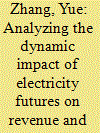

|
|
|
|
|
| Summary/Abstract |
Though the electricity market in China has gone through several reforms in the last few decades, the market is still not completely liberalized. The wholesale prices are regulated and for renewable it is based on feed-in tariff; there is not yet a competitive spot or derivative market concerning the generation side. Furthermore, with great potential, renewable energy is being gradually promoted by the government to compete freely with conventional energies. However, it is hard for a renewable generator to survive without subsidy. So, in this paper we propose a new round of revolution in power sector to introduce electricity futures into China with the expectation of perfecting the market and providing a proper hedging tool for renewable plants. We make an estimation of the risk premium and then simulate the futures prices in China's market. To support the establishment of the futures contracts, we also propose two pricing mechanisms: Demand-side price & Opportunity cost price and study their effects on the futures. Finally, some suggestions with regard to the construction of futures market in China and the operational strategy for renewable plants are given.
|
|
|
|
|
|
|
|
|
|
|
|
|
|
|
|
| 7 |
ID:
166966


|
|
|
|
|
| Summary/Abstract |
We analyze the effectiveness of California's “Replace Your Ride” policy, a pilot program that gives subsidies to lower income households in the greater Los Angeles area to retire older vehicles and replace them with newer, cleaner vehicles. Using a differences in differences strategy to compare changes in new vehicle purchase probabilities between income eligible and ineligible households before and after the implementation of the program, we find that in 2015, upwards of 44% of plug-in electric vehicle and 78% of hybrid vehicle purchases under the program were additional.
|
|
|
|
|
|
|
|
|
|
|
|
|
|
|
|
| 8 |
ID:
166922


|
|
|
|
|
| Summary/Abstract |
Since 2010, the installed capacity of solar photovoltaic (PV) penetration in Hawai'i has soared due to exceedingly high electricity rates, generous installation tax credits, and net energy metering. The inherent variability of solar resources and changes in customer behavior impose increasing volatility at the circuit level, which poses challenges with grid stability. This study uses a rich and unique proprietary data set to assess the interrelated effects of weather and socio-economic factors on power system operations to maintain a balance between load and supply of solar photovoltaic at the system level. We find that PV penetration, weather and residents on circuit contribute greatly to volatility under varying operating regimes. In the end, Hawai'i shows that “old grids” can tolerate much higher level of penetration than previously understood.
|
|
|
|
|
|
|
|
|
|
|
|
|
|
|
|
| 9 |
ID:
166942


|
|
|
|
|
| Summary/Abstract |
An assessment model is built to investigate the degree of order in the organisational structure of the electricity regulatory institution (ERI) in China. The model is based on Shannon entropy and is constructed from the perspective of timeliness and accuracy of the flow of information. The model is then used to evaluate the degree of order in the organisational structures of the ERI during three stages of reform that occurred during 2002–13. The results indicate that the reforms and improvements made in the organisational structure of China's ERI have resulted in a stepwise increase in their degree of order (corresponding to 0.3156, 0.3277, and 0.3324 in the three stages, respectively). On this basis, a scheme is put forward to optimise the degree of order in the structure of the energy regulatory institution in the current stage. The results show that downsizing the internal and subordinate departments appropriately and creating more governmental agencies to regulate energy are conducive to further improving the degree of order of the energy regulatory institution. Finally, we use principal component analysis to propose a priority scheme for adding more regulatory governmental agencies based on sorted energy production and consumption data.
|
|
|
|
|
|
|
|
|
|
|
|
|
|
|
|
| 10 |
ID:
167013


|
|
|
|
|
| Summary/Abstract |
This paper analyses the scale of asset stranding of global natural gas production and transmission infrastructure between 2015 and 2060 using Gas-GAME-Spot, an agent-based gas-sector model. It extends the existing modelling efforts by considering contract constraints in short-term gas sales and explicitly simulating trade in two types of spot markets. The study also contributes to the methodologies of stranded asset analysis by taking into account two aspects which are commonly overlooked: market fluctuation subject to the changing export capacities and the impacts of market signals on investor decision making. The results of the base scenario indicate that if gas demand follows current policy expectations, the scale of asset stranding is likely to be limited. This is attributed to supply capacity shortage of medium-sized exporters due to a slowing of their investment. Moreover, two alternative scenarios show that, when the markets face sudden reduction in demand, they leverage the flexibilities in their long-term contracts and opt more gas through spot trade. Though the issue of stranding is not significant globally in these scenarios, exporting regions with high short-run delivery costs, especially North America and Australia, have higher risks of asset stranding as they are arguably less competitive in spot sales.
|
|
|
|
|
|
|
|
|
|
|
|
|
|
|
|
| 11 |
ID:
166921


|
|
|
|
|
| Summary/Abstract |
This paper adopts data envelopment analysis, namely the range adjusted measure (RAM) which is based on the additive structure, to measure the technical efficiency and productivity change. Note that we distinguish among energy and non-energy inputs in the analysis. The Luenberger productivity indicator is decomposed for the provinces of China for the period of 2006–2015. Specifically, we seek to identify the key directions for energy conservation and emission reduction by analyzing the environmental productivity change decomposition. The results show that sulfur dioxide and carbon dioxide emissions from primary energy consumption along with primary energy consumption are important variables contributing to atmospheric environmental inefficiency in Chinese provinces. Furthermore, static efficiency scores associated with energy consumption and atmospheric emission (sulfur dioxide, nitrogen oxides and carbon dioxide emissions) are lower for Hebei, Shandong, Henan and Shanxi in North China, whereas Beijing, Tianjin, Shanghai, Guangdong and Fujian show higher values of this kind of efficiency. Atmospheric emissions contribute to the growth in the atmospheric environmental productivity to a higher extent if compared to energy consumption. Therefore, Chinese energy policy should address the environmental regulation of energy consumption.
|
|
|
|
|
|
|
|
|
|
|
|
|
|
|
|
| 12 |
ID:
166979


|
|
|
|
|
| Summary/Abstract |
To what extent can energy infrastructure become a tool for insurgents? Non-state, insurgent actors have increased attacks on critical energy infrastructure over time (Giroux et al., 2013). As critical energy infrastructure becomes more complex and interconnected, attacks on this infrastructure can have far reaching consequences not only for the economy but also for social institutions. Leveraging exogenously scheduled elections in Colombia and microlevel energy infrastructure attack data, we use multivariate linear regression to show that insurgent groups, Las Fuerzas Armadas Revolucionarias de Colombia (FARC) and Ejército de Liberación (ELN), time attacks on critical energy infrastructure in the months before an election. We find that the likelihood of an attack on electricity transmission lines and substations increased by 34% in the lead up to election months and that the number of attacks increased by 37% during election months. We further find these attacks are correlated with reduced voter turnout, indicating that infrastructure attacks may undermine participation in democratic institutions. These findings are particularly interesting as democratic societies—burgeoning and established—try to identify the unintended vulnerabilities to society that accompany the benefits of increased interconnectedness.
|
|
|
|
|
|
|
|
|
|
|
|
|
|
|
|
| 13 |
ID:
166923
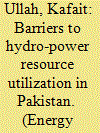

|
|
|
|
|
| Summary/Abstract |
The share of hydro power in the energy mix of Pakistan has not exceeded beyond 40% despite abundant hydro-power potential in the country. Owing to the slow pace of hydro-power development under the public sector, various policy frameworks and institutional arrangements have been introduced to develop the resources by involving the private sector. Even those arrangements have not succeeded in directing the attention of private investment towards the hydropower but the thermal sector. This study investigates the reasons behind the slow progress of hydro-power sector in Pakistan. A mixed approach comprising NVIVO analysis and Q methodology has been used to explore the impending reasons. Both, primary and secondary data, in the form of interviews, published reports, papers and other documents related to the hydro-power sector of Pakistan were collected for the analysis purpose. NVIVO analysis of primary and secondary data identified important variables that were further used for Q methodology. Q methodology revealed four important discourses on barriers to the hydro-power development in Pakistan. Discourses included less participation of private sector in running the electricity market operations, incoherent planning, financial barriers and institutional barriers. The revelation of these discourses is important for framing policies on the development of indigenous renewable energy resources in Pakistan.
|
|
|
|
|
|
|
|
|
|
|
|
|
|
|
|
| 14 |
ID:
166931


|
|
|
|
|
| Summary/Abstract |
This paper presents a quasi-randomized controlled trial in a workplace with personalized lighting control and investigates the impact of automated demand response (DR) on employees. It also clarifies what type of conditions will make employees participate in DR. To meet this objective, we set up four treatment groups: opt-in performance incentive, opt-in fixed incentive, opt-out performance incentive, and opt-out fixed incentive. In the experiment, the group with the highest participation rate is the opt-out fixed incentive. Subsequently, we estimate two average treatment effects (intent-to-treat and treatment-on-treated) for DR. The results reveal a significant reduction in electricity consumption during peak hours for all four treatment groups. We find that although the DR participation rate is high for the opt-out group, its average energy-saving effect is not significantly different than that for the opt-in group, and the average energy-saving amount of opt-in consumers is larger than that of opt-out consumers. We also show a similar trade-off between the participation rate and the power-saving effect for employees participating in DR.
|
|
|
|
|
|
|
|
|
|
|
|
|
|
|
|
| 15 |
ID:
167010


|
|
|
|
|
| Summary/Abstract |
Behavioural interventions, such as informational nudges, have become an increasingly popular strategy in demand-side energy management. In particular, home energy reports (HERs) have been used to induce behavioural change among residential consumers. These HERs typically provide peer comparisons of energy use and information about energy savings opportunities. Despite the growing prevalence of HERs and a shift from postal to electronic delivery of HERs, the experimental evidence base of their effectiveness comes primarily from HERs delivered by post from a single vendor (Opower). Whether that evidence generalises to other programmes and to the electronic delivery of HERs is unclear. This paper reports new evidence for HER effectiveness from a 12-month field experiment with approximately 9,000 households that tested electronic HER programme in a deregulated American residential electricity market. Despite high non-compliance with HER delivery, the programme reduced household electricity consumption by 2.9%, 95% CI [-5.0%, −0.76%]. This estimated reduction is consistent with prior estimated impacts of HERs delivered by post and implies electronic HERs are at least as effective as reports delivered by post in reducing electricity consumption, while they are administered at a lower cost.
|
|
|
|
|
|
|
|
|
|
|
|
|
|
|
|
| 16 |
ID:
166970
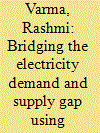

|
|
|
|
|
| Summary/Abstract |
Efficient and reliable electricity supply is critical for economic growth. India is facing multiple challenges of meeting country's electricity requirement, finding suitable resource transition from depleting fossil fuels and addressing the concern of climate change.
|
|
|
|
|
|
|
|
|
|
|
|
|
|
|
|
| 17 |
ID:
166929
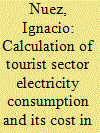

|
|
|
|
|
| Summary/Abstract |
The Canary Islands is a European archipelago whose principal economic activity is international tourism. Due to its geographic isolation, it does not have any connection with continental electricity grids. The Spanish state subsidises the extra cost of electrical energy generation in isolated systems. The purpose of this study is to quantify the proportion of the electricity bill that corresponds to tourist activity that is being subsidised. With this aim, three complementary methodologies have been developed. These tools could also be used in similar environments. The results reveal an average tourist sector consumption in the study years (2014–2017) between 12.8% and 16.5% of the total amount of electricity generated in the archipelago, with a monetary value of Spanish state subsidy estimated in €143.5 M in the year 2014. Additionally, a calculation was made of the values of CO2 emissions due to tourist electricity consumption for the years of the study period, with an estimated peak of 1.1 MtCO2 in 2017. From the point of view of energy policy, these results could be used to justify the adoption of various types of compensatory measures, including ecotaxes to be paid by the tourist visitor.
|
|
|
|
|
|
|
|
|
|
|
|
|
|
|
|
| 18 |
ID:
167033


|
|
|
|
|
| Summary/Abstract |
This study aims to quantify the incidence of energy poverty in Cambodia and its potential impact on the social wellbeing of the people of Cambodia. The notion of energy poverty of a household is not well understood in the context of literature as it may refer to either ‘energy poor’ or ‘economically poor’ condition of the household. This study defines energy poverty in terms of lack of accessibility and/ or affordability of energy, which may cause the deprivation of a household and affect its wellbeing. The study uses the latest Cambodia Socio-Economic Survey Data 2015 (CSES 2015) to investigate the impacts of energy poverty on the health, education and earning opportunities of the households. The findings of the study suggest that energy poverty of a household is strongly associated with the type of fuel used and low consumption of unaffordable clean energy by the household. The resulting impacts of energy poverty on the wellbeing of households are enormous. Energy poor households have a higher probability of its members suffering from respiratory problems, spending more on medical care, having a higher dropout rate from schools and lower earning opportunities than the households without energy poverty. Based on its findings, the study suggests an urgent need of policy measures focusing on provision of clean and affordable energy to poor households to reduce / eliminate energy poverty in Cambodia.
|
|
|
|
|
|
|
|
|
|
|
|
|
|
|
|
| 19 |
ID:
167024
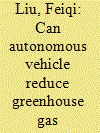

|
|
|
|
|
| Summary/Abstract |
Autonomous vehicles are believed to be the next-generation technology for future societies. The energy and environmental impacts of autonomous vehicles have been realized to be important issues, but quantitative analysis is lacking. In this study, by using China's passenger vehicle fleet as an example, we evaluate the effects of autonomous vehicle deployment on greenhouse gas emissions in different scenarios of autonomous vehicle penetration rates and fuel consumption changes. A comprehensive literature review is conducted to support the study. Autonomous vehicles are found to potentially affect the total greenhouse gas emissions in multiple ways, including reducing vehicle ownership, increasing vehicle use intensity, and changing the vehicle fuel consumption rate. These impacts are mostly internally offset such that the overall impact of autonomous vehicle deployment on greenhouse gas emissions is not significant in the near-to mid-term. With a higher autonomous vehicle penetration rate achieved, in the optimistic scenario, a net reduction in greenhouse gas emissions is expected to be realized. In addition, the fuel economy levels of autonomous vehicles are highly uncertain and cause major uncertainties in the simulation results. More field tests and evidence are needed to improve the evaluation reliability.
|
|
|
|
|
|
|
|
|
|
|
|
|
|
|
|
| 20 |
ID:
166992


|
|
|
|
|
| Summary/Abstract |
In accordance with the commitment of China to reducing emissions consistent with the Kyoto Protocol, the total carbon emissions of the nation mandatorily require fair allocation to all of the provinces in order to properly handle the relationship between development and emissions reduction. The current paper carries out an evaluation of the status of carbon emissions in China for the year 2012. Considering the viewpoint of Max-min satisfaction, the data envelopment analysis (DEA) is applied for the achievement of a fixed cost allocation. Through the comparison of the allocated amount of carbon emissions with the actual carbon emissions, we perform an analysis and evaluation of the use of carbon emission rights in all provinces. Two of the key findings are presented as follows: The utilization rate of carbon emission in eastern China is termed as the lowest, followed by the utilization in central China. However, the utilization rate of carbon emission in the western region is considered as the best. On the basis of our analysis, guidelines are put forward for a production plan that incorporates energy saving as well as emission reduction.
|
|
|
|
|
|
|
|
|
|
|
|
|
|
|
|
|
|
|
|
|